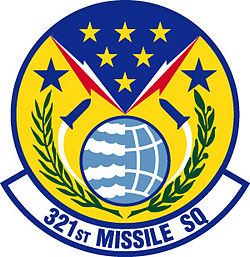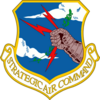321st Missile Squadron
| 321st Missile Squadron | |
|---|---|
Philippine Presidential Unit Citation | |
| Commanders | |
| Current commander | Lt. Col. David Bull |
| Insignia | |
| 321st Missile Squadron emblem (approved 4 November 1965)[1] |  |
| Patch with unofficial 321st Strategic Reconnaissance Squadron emblem[2] |  |
| 321st Bombardment Sq emblem (approved 27 March 1943)[3] |  |
| 321st Bombardment Squadron "Jolly Rogers" patch[note 1] |  |
The 321st Missile Squadron is a
History
World War II

The

The squadron moved to
The squadron attacked enemy
During 1944, the 321st supported the New Guinea Campaign through the end of June, then made long-range raids on oil refineries at
After
Superfortress operations
The squadron was reactivated in July 1947 as a very heavy unit at

The squadron was again organized at Fairchild Air Force Base, Washington in January 1951 and equipped with the Boeing B-29 Superfortress. In February, as part of a reorganization of Strategic Air Command wings, the 90th Bombardment Group was reduced to paper status and the squadron was attached to the wing for operational control. In June 1952, this organization, which was designed to permit the wing commander to focus on the wing's combat units and the maintenance necessary to support combat aircraft, was formalized as the Dual Deputy Organization and the squadron was assigned to the wing.[7][8]
In March 1951, the squadron moved to
In June, the squadron added duty as a Replacement Training Unit, primarily providing individual training for aircrew being assigned to existing
Strategic reconnaissance

The squadron began to fly strategic reconnaissance missions in September 1953.
Intercontinental ballistic missiles
The squadron was reactivated on 9 April 1964 as an
The squadron won the
Lineage
- Constituted as the 321 Bombardment Squadron (Heavy) on 28 January 1942
- Activated on 15 April 1942
- Redesignated 321 Bombardment Squadron, Heavy on 6 March 1944
- Inactivated on 27 January 1946
- Redesignated 321 Bombardment Squadron, Very Heavy on 11 June 1947
- Activated on 1 July 1947
- Inactivated on 6 September 1948
- Redesignated 321 Bombardment Squadron, Medium on 20 December 1950
- Activated on 2 January 1951
- Redesignated 321 Strategic Reconnaissance Squadron, Medium on 16 June 1952
- Discontinued on 20 June 1960
- Redesignated 321 Strategic Missile Squadron (ICBM-Minuteman) on 16 September 1963
- Organized on 9 April 1964
- Redesignated 321 Missile Squadron on 1 September 1991[1]
Assignments
- 90th Bombardment Group, 15 April 1942 – 27 January 1946
- 90th Bombardment Group, 1 July 1947 – 6 September 1948
- 90th Bombardment Group, 2 January 1951 (attached to 90th Bombardment Wingafter 16 February 1951)
- 90th Strategic Reconnaissance Wing, 16 June 1952 – 20 June 1960
- Strategic Air Command, 16 September 1963 (not organized)
- 90th Strategic Missile Wing, 9 April 1964
- 90th Operations Group, 1 September 1991 – present[1]
Stations
- Key Field, Mississippi, 15 April 1942
- Barksdale Field, Louisiana, 17 May 1942
- Greenville Army Air Base, South Carolina, 21 June 1942
- Willow Run Airport, Michigan, 9–23 August 1942
- Wheeler Field, Hawaii, 12 September 1942
- Iron Range Airfield, Queensland, Australia, c. 4 November 1942
- Jackson Airfield (7 Mile Drome), Port Moresby, New Guinea, 10 February 1943
- Dobodura Airfield Complex, New Guinea, December 1943
- Nadzab Airfield Complex, New Guinea, c. 23 February 1944
- Biak Island, Netherlands East Indies, 12 August 1944
- McGuire Field, Mindoro, Philippines, 26 January 1945
- Ie Shima Airfield, Okinawa, 15 August 1945
- Fort William McKinley, Luzon, Philippines, 23 November 1945 – 27 January 1946
- Andrews Field (later Andrews Air Force Base), Maryland, 1 July 1947 – 6 September 1948
- Fairchild Air Force Base, Washington, 2 January 1951
- Forbes Air Force Base, Kansas, 14 March 1951 – 20 June 1960
- Francis E. Warren Air Force Base, Wyoming, 9 April 1964 – present[1]
Aircraft and missiles
- Consolidated B-24 Liberator (1942–1945)
- Boeing RB-29 Superfortress(1951–1954)
- Boeing RB-47E Stratojet(1954–1960)
- LGM-30B Minuteman I(1964–1974)
- LGM-30G Minuteman III (1973 – Present)
Awards and campaigns
| Award streamer | Award | Dates | Notes |
|---|---|---|---|
Distinguished Unit Citation |
c. 4 November 1942 – 23 January 1943 | Papua, 321st Bombardment Squadron[1] | |
| Distinguished Unit Citation | 13 and 15 September 1943 | New Guinea, 321st Bombardment Squadron[1] | |
Air Force Outstanding Unit Award |
1 July 1968 – 30 June 1969 | 321st Strategic Missile Squadron[1] | |
| Air Force Outstanding Unit Award | 1 July 1973 – 30 June 1975 | 321st Strategic Missile Squadron[1] | |
| Air Force Outstanding Unit Award | 1 July 1977 – 30 June 1979 | 321st Strategic Missile Squadron[1] | |
| Air Force Outstanding Unit Award | 1 July 1982 – 30 June 1984 | 321st Strategic Missile Squadron[1] | |
| Air Force Outstanding Unit Award | 1 July 1987 – 30 June 1989 | 321st Strategic Missile Squadron[1] | |
| Air Force Outstanding Unit Award | 1 August 1991 – 31 July 1993 | 321st Strategic Missile Squadron (later 321st Missile Squadron)[1] | |
| Air Force Outstanding Unit Award | 1 October 1994 – 30 September 1995 | 321st Missile Squadron[1] | |
| Air Force Outstanding Unit Award | 1 September 1996 – 31 August 1998 | 321st Missile Squadron[1] | |
| Air Force Outstanding Unit Award | 1 October 1999 – 30 September 2000 | 321st Missile Squadron[1] | |
| Air Force Outstanding Unit Award | 1 January 2001 – 31 December 2001 | 321st Missile Squadron[1] | |
| Air Force Outstanding Unit Award | 1 October 2003 – 30 September 2005 | 321st Missile Squadron[1] | |
| Air Force Outstanding Unit Award | 1 October 2005 – 30 September 2007 | 321st Missile Squadron[1] | |
| Air Force Outstanding Unit Award | 1 October 2007 – 30 September 2008 | 321st Missile Squadron[1] | |
| Air Force Outstanding Unit Award | 1 October 2008 – 31 May 2010 | 321st Missile Squadron[1] | |
| Air Force Outstanding Unit Award | 1 January 2011 – 31 December 2012 | 321st Missile Squadron[1] | |
| Philippine Republic Presidential Unit Citation | 17 October 1944 – 4 July 1945 | 321st Bombardment Squadron[1] |
| Campaign Streamer | Campaign | Dates | Notes |
|---|---|---|---|
| Guadalcanal | c. 4 November 1942 – 21 February 1943 | 321st Bombardment Squadron[1] | |
| Papua | c. 4 November – 23 January 1943 | 321st Bombardment Squadron[1] | |
| Northern Solomons | 23 February 1943 – 21 November 1944 | 321st Bombardment Squadron[1] | |
| Bismarck Archipelago | 15 December 1943 – 27 November 1944 | 321st Bombardment Squadron[1] | |
| New Guinea | 24 January 1943 – 31 December 1944 | 321st Bombardment Squadron[1] | |
| Leyte | 17 October 1944 – 1 July 1945 | 321st Bombardment Squadron[1] | |
| Luzon | 15 December 1944 – 4 July 1945 | 321st Bombardment Squadron[1] | |
| Southern Philippines | 27 February 1945 – 4 July 1945 | 321st Bombardment Squadron[1] | |
| China Defensive | November 1942 – 4 May 1945 | 321st Bombardment Squadron[1] | |
| China Offensive | 5 May 1945 – 2 September 1945 | 321st Bombardment Squadron[1] | |
| Air Offensive, Japan | November 1942 – 2 September 1945 | 321st Bombardment Squadron[1] | |
| Western Pacific | 17 April 1944 – 2 September 1945 | 321st Bombardment Squadron[1] |
See also
41°07′59″N 104°52′01″W / 41.13306°N 104.86694°W
- 321st Missile Squadron Launch Facilities
- B-24 Liberator units of the United States Army Air Forces
- List of United States Air Force missile squadrons
References
Notes
- ^ The 90th Bombardment Group "Jolly Rogers" emblem was used as a squadron patch and as a tail marking on B-24s with each squadron having its own color in the background. Watkins, pp. 86–87
- ^ Aircraft is Boeing B-29-100-BW Superfortress serial 45-21846
- ^ Replacement Training Units trained individuals to fill positions in existing units. See Goss, p. xxxvi
Citations
- ^ a b c d e f g h i j k l m n o p q r s t u v w x y z aa ab ac ad ae af ag ah ai aj ak Bailey, Carl E. (18 June 2015). "Factsheet 321 Missile Squadron (AFGSC)". Air Force Historical Research Agency. Archived from the original on 11 June 2016. Retrieved 17 May 2016.
- ^ Maurer, Combat Squadrons, p. 394 (no approved emblem).
- ^ Watkins, pp. 86–87
- ^ a b c d Robertson, Patsy (27 May 2010). "Factsheet 90 Operations Group (AFSPC)". Air Force Historical Research Agency. Retrieved 8 August 2017.
- ^ Mueller, p. 8
- ^ Maurer, Combat Units, pp. 102, 176, 178
- ^ a b c d e f Robertson, Patsy (6 April 2012). "Factsheet 90 Missile Wing (AFGSC)". Air Force Historical Research Agency. Retrieved 8 August 2017.
- ^ Deaile, pp. 175–176
- ^ Ravenstein, pp. 200–202
- ^ Robertson, Patsy (27 August 2015). "Factsheet 308 Armament Systems Wing (AFMC)". Air Force Historical Research Agency. Archived from the original on 27 September 2015. Retrieved 8 August 2017.
- ^ Kane, Robert B. (23 December 2010). "Factsheet 310 Space Wing (AFRC)". Air Force Historical Research Agency. Retrieved 8 August 2017.
- ^ "Abstract, History 90 Bombardment Wing". Air Force History Index. 1 October 1951. Retrieved 9 May 2016.
- ^ 90th Missile Wing Heritage Pamphlet, pp. 3, 15
- ^ 90th Missile Wing Heritage Pamphlet, p. 15
- ^ Ravenstein, p. 68
- ^ a b "90 MW Fact Sheet". 90th Missile Wing Public Affairs. 19 August 2010. Retrieved 8 May 2016.
- ^ 90th Missile Wing Heritage Pamphlet, p. 9
Bibliography
![]() This article incorporates public domain material from the Air Force Historical Research Agency
This article incorporates public domain material from the Air Force Historical Research Agency
- Deaile, Melvin G. (2007). The SAC Mentality: The Origins of Organizational Culture in Strategic Air Command 1946–1962. Chapel Hill, NC: University of North Carolina. Retrieved 14 February 2015.
- Maurer, Maurer, ed. (1983) [1961]. Air Force Combat Units of World War II (PDF) (reprint ed.). Washington, DC: Office of Air Force History. LCCN 61060979. Archived from the original(PDF) on 20 December 2016.
- Maurer, Maurer, ed. (1982) [1969]. Combat Squadrons of the Air Force, World War II (PDF) (reprint ed.). Washington, DC: Office of Air Force History. OCLC 72556. Archived from the original(PDF) on 20 August 2023.
- Ravenstein, Charles A. (1984). Air Force Combat Wings, Lineage & Honors Histories 1947–1977. Washington, DC: Office of Air Force History. ISBN 0-912799-12-9.
- Watkins, Robert A. (2013). Insignia and Aircraft Markings of the U.S. Army Air Force in World War II. Vol. V, Pacific Theater of Operations. Atglen, PA: Shiffer Publishing, Ltd. ISBN 978-0-7643-4346-9.
- "90th Missile Wing Heritage" (PDF). Office of History 90th Missile Wing. Retrieved 9 May 2016.
External links
- Kirk, Jim. "Warren AFB Minuteman Missile Site Coordinates". ASUW Link. Archived from the original on 25 June 2014. Retrieved 31 May 2016.
- Fields, Dave. "Minuteman Missile: A Tribute to the ICBM Program". Dave Fields. Archived from the original on 7 July 2016. Retrieved 7 July 2016.




